When a tree has been identified as having a pest issue or is susceptible to an impending lethal pest attack, there are several options available to address the problem. Prior to the use of chemicals, it’s best to monitor the situation and collect information pertaining to the site, host plant, and pest (e.g., identify, determine population levels and life stages, etc.). This can aid management decisions and provide a targeted approach to treating for a pest. It’s possible that improper cultural practices (e.g., poor sanitation, lack of irrigation, improper pruning, overfertilization) have produced conditions that are conducive to a particular pest. Poor cultural practices can stress trees, making them more susceptible to a pest infestation. Cultural practices that adhere to proper tree care guidelines can help prevent potential pest issues and reduce the need for chemical intervention. Additionally, the use of mechanical controls (e.g., traps) or biological controls (e.g., natural enemies of the pest) might be viable alternatives, depending on the severity of the infestation. In the event that none of the aforementioned methods effectively address the issue, pesticides can be an effective approach.
There are many different modes of applying chemical controls to a tree (e.g., foliar and basal sprays, injections, and drenches) and numerous variables that need to be considered (e.g., safety, efficacy of the control, pest phenology, target pest, toxicity, legal constraints, weather conditions, etc.) when deciding which method is most appropriate for a given situation. Prior to treating any tree with a pesticide, it is important to receive the proper training and required licensing (i.e., state pesticide applicators license—public or commercial). Additionally, the necessary personal protective equipment should be worn when applying chemical controls (e.g., gloves, safety glasses, etc.) in accordance with the product label. The remainder of this article focuses on trunk injections and soil applications of pesticides to trees.
Injection application may be made directly into the trunk of the tree or the soil underneath it near the roots. Injection of pesticides into a tree trunk directly applies concentrated systemic pesticides into a tree's vascular (xylem) tissues for faster translocation (Figure 1). Soil injection places the pesticide below mulch or turf and directly into the root zone of the tree. Soil drenching is similar to soil injection, except the pesticide mixture is poured onto the soil surrounding the tree base. Drenching and injecting have the same net benefits in that the pesticide quickly enters the tree's vascular system. These types of applications are particularly effective in controlling some of the most troublesome insect pests of ornamental landscape trees, including aphids, scale insects, and whiteflies.
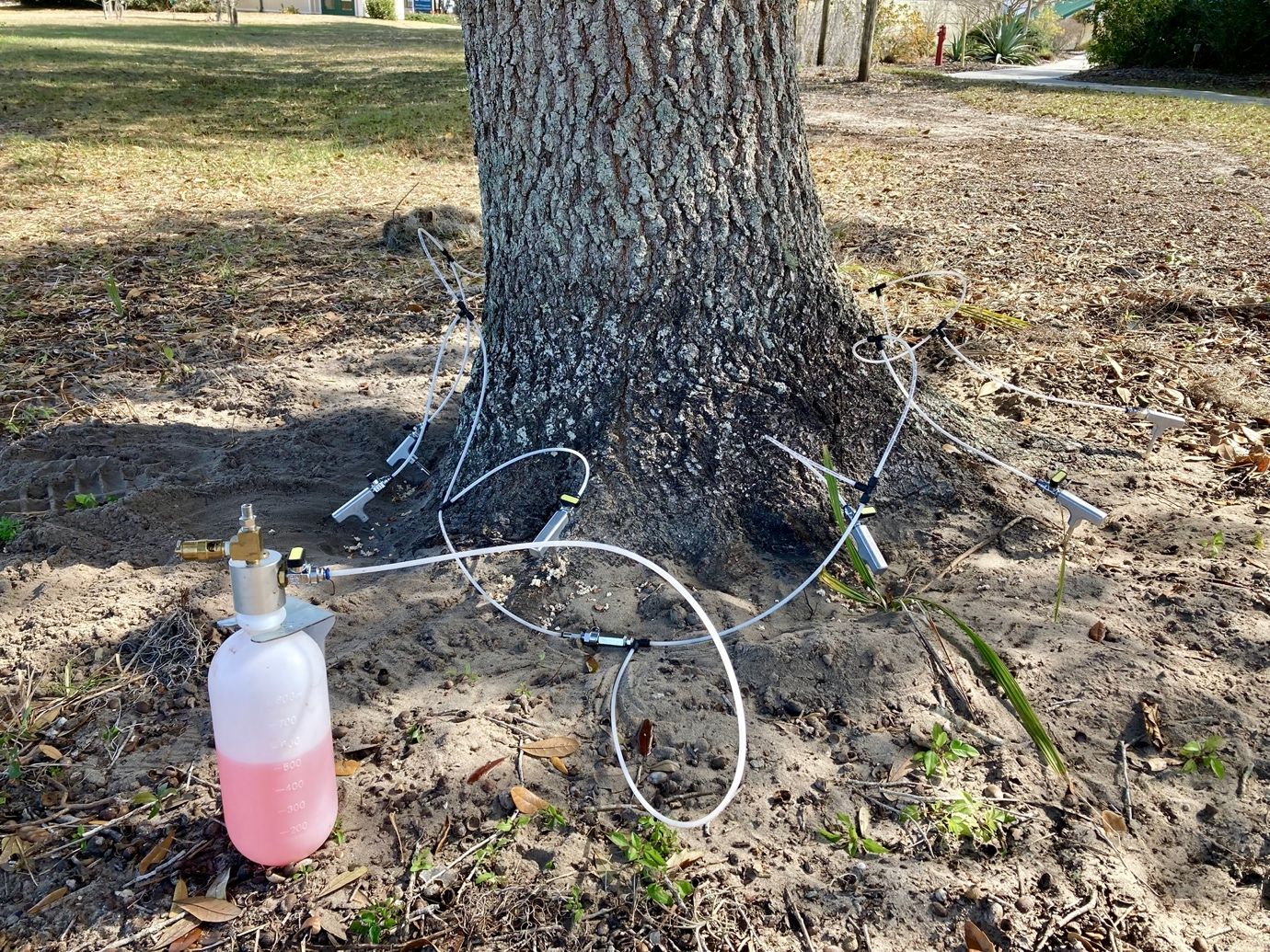
Credit: Adam Dale, UF/IFAS
A wide variety of products, including plant growth regulators, nutrients, antibiotics, and pesticides, are available for use by professional applicators and arborists with these technologies (Table 1). Commercial use of these application techniques in ornamental landscapes requires the proper pest control license under the Florida Department of Agriculture and Consumer Services. Check the label of any pesticide intended to be applied with these techniques to ensure your use is included. Furthermore, the state periodically updates its approved pesticide list. Thus, prior to applying any chemical controls, it’s best to verify that the product you intend to use is still permissible by law.
Advantages of tree injection and soil application:
- Little, if any, pesticide applied is wasted to drift or runoff with tree injection, because it can be applied directly to where it is taken up by the tree.
- Pesticide applications via trunk injection may be made during windy and rainy weather because there is no drift or runoff.
- Trunk injections can be used on sites where soil treatments may not be practical, effective, or appropriate, including trees growing on excessively wet, sandy, compacted, or restricted-soil environments.
- There is little nontarget organism exposure by tree injection; therefore, it can be done in environmentally sensitive areas or areas with high human traffic or proximity.
- Injection methods for treating some of Florida's troublesome piercing-sucking insects of trees, such as whiteflies and aphids, can be particularly useful.
- With soil injections or drenching, trees are not wounded.
- The soil drench method requires almost no tools, other than a bucket or watering can.
Disadvantages of these methods include:
- Trunk injections cause wounding and subsequent injury and may facilitate entrance of pathogens. Note that injection wounds on hardwoods will eventually close over following injection, while palms will not.
- Trunk injections can be more costly and labor-intensive.
- Coverage with trunk injections can be uneven throughout the crown.
- Injection equipment can be costly.
- Higher volume of chemicals must be used with soil drenching than with injection.
Soil Injection and Drenching
Soil injection or drench methods involve placing chemicals in liquid form near the roots in the soil for root uptake. As with the other injection methods, the chemicals must be water soluble. Chemicals should be applied to moist (but not saturated) soil to achieve the best uptake.
With the soil drench method, you simply pour chemical mixed in water on the soil near the tree's root crown. Mulch or other surface organic matter is pulled back and the chemical is poured directly on the soil. Then, the mulch is replaced. The amount of chemical used is based on inches of trunk diameter at breast height (DBH) and will be stated on the label.
Tree DBH can be measured with a flexible tape measure or a diameter tape. If using a tape measure, measure the circumference of the trunk at chest height (~4.5 ft from the ground) and divide that value by 3.14 to determine the diameter. If using a diameter tape, simply wrap the tape around the trunk at chest height and record the diameter. For more details on calculating tree DBH, visit http://www.youtube.com/watch?v=B67QPJa2pbM&list=PLr5M0QvUoAel1dKnwLvt9EF5lEtzolyTw&index=4.
Soil injection methods vary by product and equipment, but typical recommendations are to inject chemicals 2‒4 inches deep with a high-pressure injector either within 18 inches of the trunk or on a grid within the tree’s canopy dripline (Figures 2‒3). Amounts to be applied also depend on trunk diameter, and diameters are added together if multiple trees are being treated in an area.
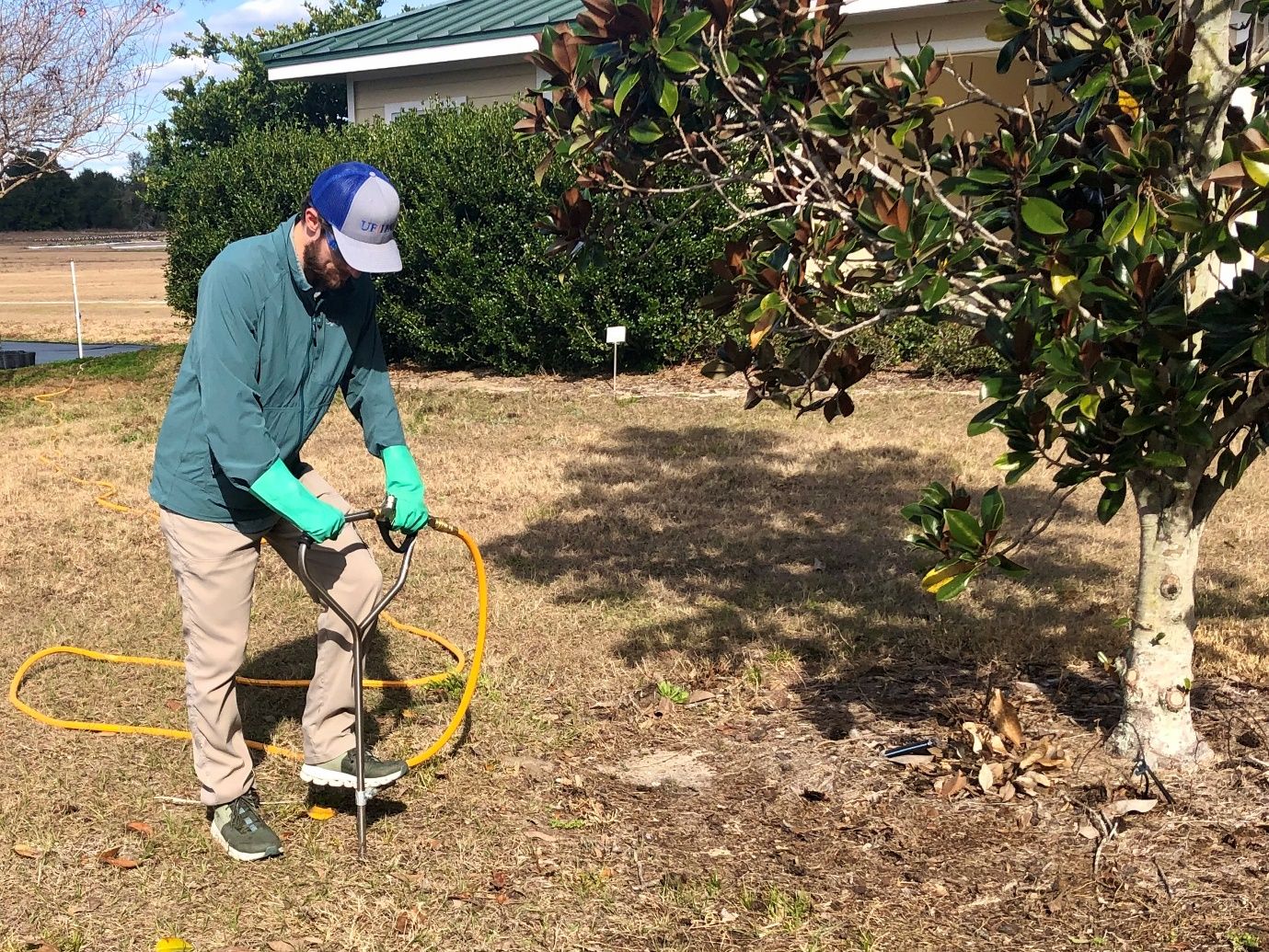
Credit: Adam Dale, UF IFAS
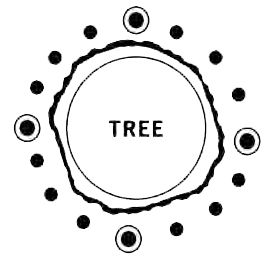
Credit: Lepitect™ product label
Tree Injection Equipment
Microinjection
Microinjection systems deliver small volumes of highly concentrated solutions into a tree. One of the best known low-pressure microinjection systems is the Mauget™ system (www.mauget.com), which uses plastic capsules that are pressurized by depressing a plunger that locks in place (Figure 4). The capsule is attached to a tube that is already inserted into the tree, breaking a seal in the capsule and releasing the pressurized chemical. Other microinjection systems that use pressurized capsules with a similar array of chemicals include Tree Tech Microinjection Systems™ (www.treetech.net) and Rainbow Treecare™ (www.rainbowecoscience.com) (Figure 5). These systems require fairly small holes (1/8" to 3/16") drilled into the tree, are fairly simple to use, and work more slowly than high-pressuremacroinjection systems.
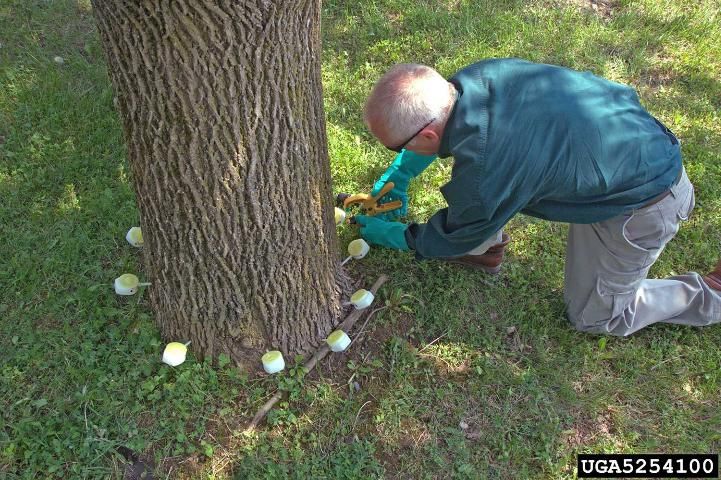
Credit: David Cappaert, bugwood.org
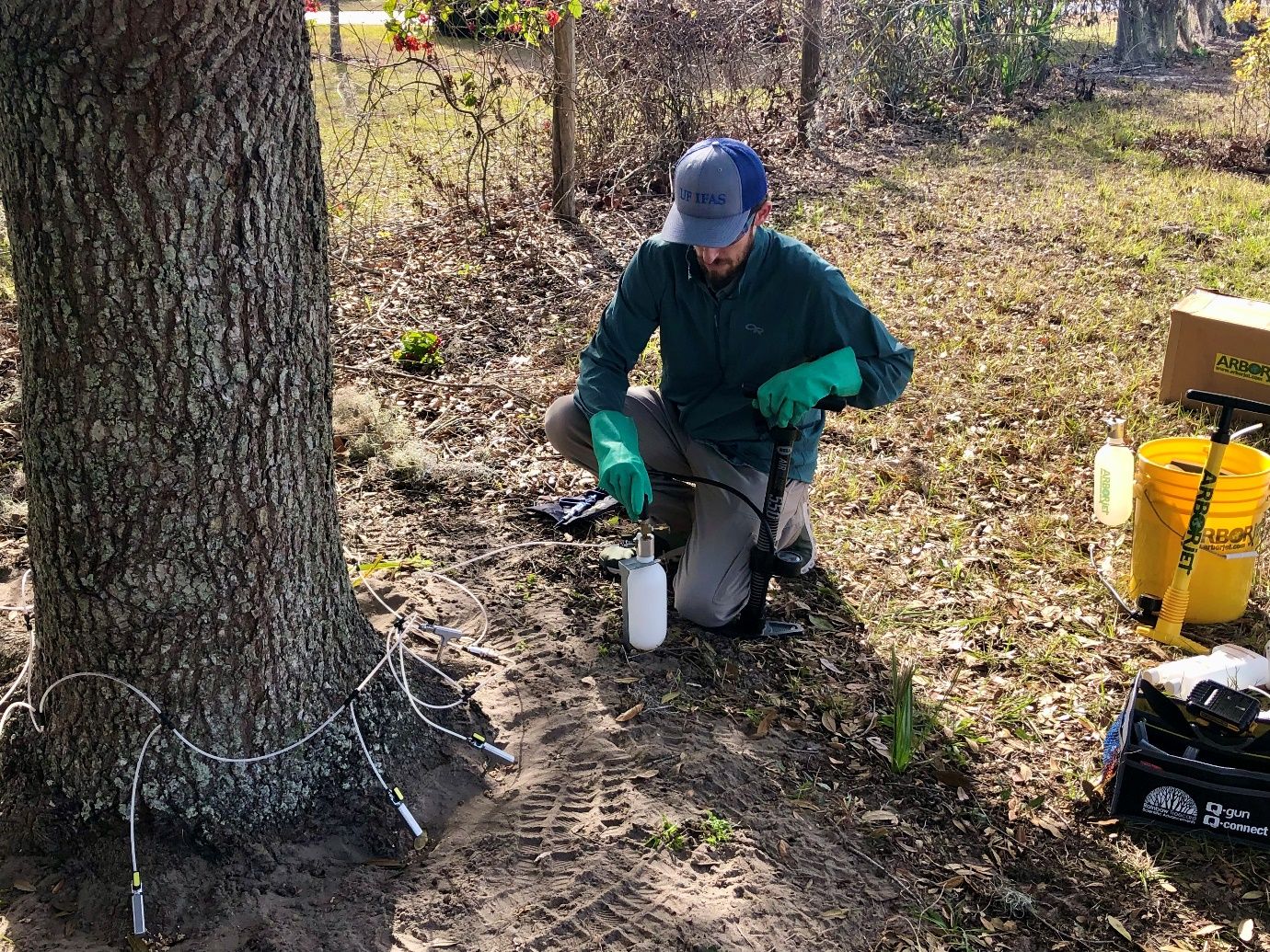
Credit: Adam Dale, UF IFAS
Macroinjection
Macroinjection systems deliver large volumes of solution to a tree, typically under high pressure. Macroinjection systems come in a variety of forms, using either a syringe or tubing, tees, and a chemical reservoir designed to be under pressure. Examples include the Arborjet® Tree I.V. system, which uses tees and tubing to deliver high volumes of chemicals from a pressurized reservoir into multiple injection sites; and their Quik-Jet® system, which applies small chemical volumes with a handheld syringe (www.arborjet.com). Rainbow Treecare™ also has macroinjection pressurized tubing and reservoir systems, including the Q-Connect system (https://www.rainbowecoscience.com/equipment/q-connect), which is similar to the Arborjet Tree I.V. but does not use injection site tees. The ArborSystem™ (www.arborsystems.com) Wedgle™ injection system doesn't use drilled holes but relies on injection through a seal with a syringe and specially designed needle. It is fairly fast because of the pressure created by the syringe. Other systems and manufacturers are also available.
Applying the Correct Amount
Some tree injection techniques, like many microinjection systems, use products that are premixed and applied through a closed system; therefore, no mixing or calibration is required. Others, like the macroinjection systems, require direct injection into holes drilled into the tree. The dose and number of holes to drill are based on the size of the tree. Additionally, the dose and recommended injection site can vary across injection systems and products. To determine the application/dose rate per tree:
- Measure the tree circumference in inches for the determining the DBH.
- Divide the circumference by 3.14 to obtain the DBH in inches.
- Calculate the number of injection sites by dividing the DBH in inches by 2.
- Multiply the tree DBH by the dosage rate to calculate the total dose in milliliters per tree.
- Divide the total dose by the number of injection sites to determine required dosage per injection site.
Example
You are hired to inject palm trees with an insecticide to control whiteflies. The product label states to apply 4 ml per inch trunk diameter at breast height.
Solution
- You measure the trunk's circumference to be 36 inches.
- Determine DBH: 36 inches ÷ 3.14 = 11.5 (round up to 12) inches DBH.
- Determine the number of injection sites: 12 inches ÷ 2 = 6 injection sites.
- Determine total dose: 12 inches × 4 ml = 48 ml total dose per tree.
- Determine amount to deliver into each injection site: 48 ml ÷ 6 injection sites = 8 ml per injection site to deliver the required dosage.
Soil Injection
With soil injection around trees and shrubs, the DBH principle is also used to determine product dosage in accordance with the product label. Injection sites around the base of the tree are based on a grid, circle, or basal system. The grid system recommends to space holes on 2.5-foot centers, in a grid pattern, extending to the dripline of the tree. With the circle system, pesticide is injected into locations spaced evenly beneath the dripline of the tree, extending in from that line. Depending on the size of the tree, more than a single circle of holes may be necessary. The basal system spaces injection sites evenly around the base of the tree trunk, no more than 6–12 inches out from the base. For each system, the required dosage is mixed into sufficient water to inject an equal amount of solution into each site. At least 4 holes per tree or shrub should be used.
The goal of soil drenching is to deliver the product uniformly in a specified volume of water per product label instructions around the base of the tree, directed to the root zone. A misconception is that if higher volumes of water are used, then the product will be diluted, or that putting on less water will result in a very concentrated product. However, whether 2 ounces of product are applied per thousand square feet mixed in 10 gallons or 100 gallons, there is no difference. When the application is over, two ounces of product have been applied.
Example
You are hired to treat ornamental trees with an insecticide as a soil drench for control of mealybugs. The product label states to apply 2 ounces of product per 10 feet of tree height and to apply the drench solution at a rate of 4 pints per inch of trunk diameter.
Solution
- You measure the trunk's circumference to be 36 inches and estimate the height to be 25 feet.
- Determine DBH: 36 inches ÷ 3.14 = 11.5 (round up to 12) inches DBH.
- Determine the amount of product to apply to the tree: 2 ounces × (25 ft ÷ 10 ft) = 5 oz.
- Determine amount of drench solution: 4 pints × 12 inch DBH = 48 pints total dose per tree.
- Convert to gallons: 48 pints ÷ 8 pints/gal = 6 gallons solution to deliver the required dosage.
Table 1. Florida-registered pesticide options available for professional injection/drench applications.1